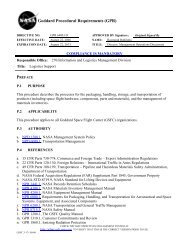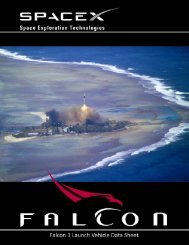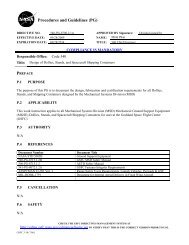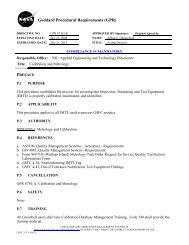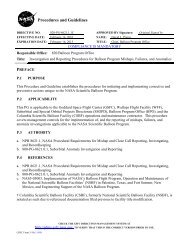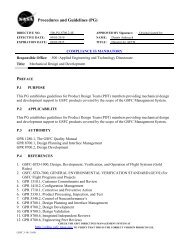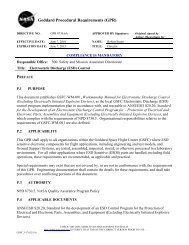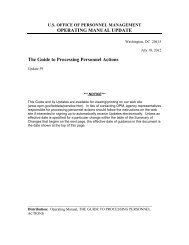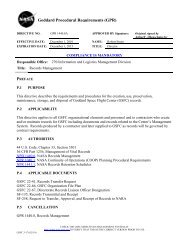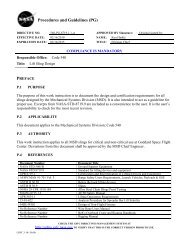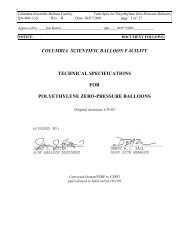<strong>ANSI</strong>/<strong>ESD</strong> <strong>S20.20</strong>-<strong>2007</strong>(This annex is not part of <strong>ANSI</strong>/<strong>ESD</strong> <strong>S20.20</strong>-<strong>2007</strong>)ANNEX A – ADDITIONAL PROCESS CONSIDERATIONSThe following sections provide guidance <strong>and</strong> outline documents that are available to help theusers evaluate additional control products <strong>and</strong> equipment. Users will need to develop their ownacceptance <strong>and</strong> compliance verification criteria as the industry has not yet defined required limitsfor these items.1. Automated H<strong>and</strong>lers (<strong>ESD</strong> SP10.1, Automated H<strong>and</strong>ling Equipment [AHE]). Todemonstrate <strong>ESD</strong> control in automated h<strong>and</strong>ling equipment, it may be necessary tomeasure resistance to ground of machine components <strong>and</strong> monitor or verify electrostaticcharge on product as it passes through the equipment. This can provide both continuousverification of <strong>ESD</strong> counter-measures <strong>and</strong> a method for locating sources of chargegeneration. This st<strong>and</strong>ard practice covers resistance-to-ground of machine components<strong>and</strong> sources of charge in automated h<strong>and</strong>ling equipment.2. Gloves (<strong>ANSI</strong>/<strong>ESD</strong> SP15.1, St<strong>and</strong>ard Practice for In-Use Resistance Testing of Gloves<strong>and</strong> Finger Cots). This st<strong>and</strong>ard practice is intended to provide test procedures formeasuring the intrinsic electrical resistance of gloves <strong>and</strong> finger cots; <strong>and</strong> electricalresistance of gloves or finger cots <strong>and</strong> personnel together as a system. This st<strong>and</strong>ardpractice applies to all gloves <strong>and</strong> finger cots used to control <strong>ESD</strong>. This st<strong>and</strong>ard practiceprovides data that are relevant in the user’s specific environment <strong>and</strong> application.3. H<strong>and</strong> Tools (<strong>ESD</strong> STM13.1, Electrical Soldering/Desoldering H<strong>and</strong> Tools). Thisst<strong>and</strong>ard test method provides electric soldering/desoldering h<strong>and</strong> tool test methods formeasuring electrical leakage <strong>and</strong> tip to ground reference point resistance. The st<strong>and</strong>ardtest method provides parameters for electrical overstress (EOS) safe soldering operation.Even though not specifically discussed in STM13.1, battery powered, pneumatic <strong>and</strong> otherh<strong>and</strong> tools may also need to be evaluated.4. <strong>ESD</strong> H<strong>and</strong>book (TR20.20). The <strong>ESD</strong> Association St<strong>and</strong>ards Committee produced this<strong>ESD</strong> H<strong>and</strong>book for individuals <strong>and</strong> organizations that are faced with controlling electrostaticdischarge (<strong>ESD</strong>). It provides guidance that can be used for developing, implementing <strong>and</strong>monitoring an electrostatic discharge control program in accordance with <strong>ANSI</strong>/<strong>ESD</strong><strong>S20.20</strong>. This H<strong>and</strong>book applies to activities that: manufacture, process, assemble, install,package, label, service, test, inspect or otherwise h<strong>and</strong>le electrical or electronic parts,assemblies <strong>and</strong> equipment susceptible to damage by electrostatic discharges greater thanor equal to 100 volts Human Body Model.Copyright 2010 by <strong>ESD</strong> Association. Licensed, by agreement, for enterpise-wide use to <strong>NASA</strong>.No other reproduction or transmission in any form is permitted without written permission of the <strong>ESD</strong>A.For inquiries or to report unauthorized use, contact info@esda.org.8
<strong>ANSI</strong>/<strong>ESD</strong> <strong>S20.20</strong>-<strong>2007</strong>ANNEX B – <strong>ESD</strong> SENSITIVITY TESTING(This annex is not part of <strong>ANSI</strong>/<strong>ESD</strong> <strong>S20.20</strong>-<strong>2007</strong>)Assessing the <strong>ESD</strong> sensitivity of parts, assemblies <strong>and</strong> equipment <strong>and</strong> their required protectionlevels can be an important element of an <strong>ESD</strong> Control Program. A common method forestablishing <strong>ESD</strong> sensitivity limits is to use one or more of the three <strong>ESD</strong> models (HBM, MM <strong>and</strong>CDM) for characterization of electronic items. The selection of specific <strong>ESD</strong> control proceduresor materials is at the option of the <strong>ESD</strong> Control Program Plan preparer <strong>and</strong> should be based onrisk assessment <strong>and</strong> the established electrostatic discharge sensitivities of parts, assemblies,<strong>and</strong> equipment.Technical literature <strong>and</strong> failure analysis data exist that indicate <strong>ESD</strong> failures are due to a complexseries of interrelated effects. Some of the factors that influence <strong>ESD</strong> sensitivity include the <strong>ESD</strong>current <strong>and</strong> energy envelope, the rise time of the <strong>ESD</strong> event, device design, fabricationtechnology <strong>and</strong> device package style. Energy sensitive devices are damaged by currents throughthe resistance of a bipolar junction, protection resistor, or protection MOS transistor. Voltagesensitive devices are damaged when the breakdown voltage across the gate oxide is exceeded.<strong>ESD</strong> sensitivity testing of devices, whether performed using the HBM, MM or the CDM, provide<strong>ESD</strong> sensitivity levels for the comparison of one device to another using defined parameters.The <strong>ESD</strong> sensitivity of the device (defined in volts), as determined by using any of the definedmodels, may not be the actual failure voltage level in the manufacturing process or userenvironment. Table 4 provides a reference for various st<strong>and</strong>ards <strong>and</strong> test methods for <strong>ESD</strong>sensitivity testing.1. Human Body Model SensitivityA source of <strong>ESD</strong> damage is the charged human body, as modeled by HBM st<strong>and</strong>ards. Thistesting model represents the discharge from the fingertip of a st<strong>and</strong>ing individual delivered to theconductive leads of the device. It is modeled by a 100 pF capacitor discharged through aswitching component <strong>and</strong> 1,500 ohm series resistor into the device under test. The dischargeitself is a double exponential waveform with a rise time of 2-10 nanoseconds <strong>and</strong> a pulse durationof approximately 150 nanoseconds. The use of a 1,500 ohm series resistor means this modelapproximates a current source. All devices should be considered as HBM sensitive. The HBM<strong>ESD</strong> sensitivity of devices may be determined by testing the device using one of the referencedtest methods. HBM sensitivities can be found in RAC VZAP, Qualified Manufacturers List ofProducts (QML-19500) or Qualified Manufacturer List (QML-38535).2. Machine Model SensitivityA source of damage for the MM is a rapid transfer of energy from a charged conductor to theconductive leads of the device. This <strong>ESD</strong> model is a 200 pF capacitor discharged through a 500nH inductor directly into the device with no series resistor. Due to the lack of a series currentlimiting resistor, this model approximates a voltage source. In the real world this modelrepresents a rapid discharge from items such as charged board assembly, charged cables or theconduction arm of an automatic tester. The discharge itself is a sinusoidal decaying waveformwith a rise time of 5 to 8 nanoseconds <strong>and</strong> a period of approximately 80 nanoseconds.3. Charged Device Model SensitivityA source of damage for the CDM is the rapid discharge of energy from a charged device. The<strong>ESD</strong> event is totally device dependent, but its location relative to ground can influence the failure9Copyright 2010 by <strong>ESD</strong> Association. Licensed, by agreement, for enterpise-wide use to <strong>NASA</strong>.No other reproduction or transmission in any form is permitted without written permission of the <strong>ESD</strong>A.For inquiries or to report unauthorized use, contact info@esda.org.



